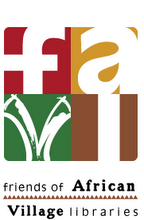What books should be stocked in a village library? This is not a difficult question is one remembers two things.
(1) Few of the books donated by American or European donors will be read as much as books published locally. This is only natural! Imagine a teenager faced with the choice of reading a short novel about an African teenager who leaves the village for the city and finds tragedy, or reading a short novel about an American teenager who befriends the ‘mean girl’ clique in her high school and begins using drugs, only to realize at the end that she has taken the wrong path. The vocabulary, cover, inflection… everything about the first book says, “I am for you.” Everything about the second book says, “You are not for me.” So donated books have to be treated with care. But they have a gigantic advantage: they are nearly free. Shipping books via the U.S. postal service is about $2 per hardcover book by air about 50 cents by surface. Compare that with a typical cost (in Burkina Faso) of $10 per book. It is worth taking the chance on donated books, and even if the readership is not there yet, the cost differential means that only about one tenth of the readership is needed. What is our practice? Donated children’s books that are animal stories, or firmly multicultural or rooted in a pre-industrial setting (not about shopping in a big-box store, or dealing primarily with electrical appliances), are what we want for younger children. For older children it is harder to know where tastes will lie, but again the level of immersion in local popular culture (how much slang is used?, how many ‘product placements’ does the book have?) is a key factor. “He glanced at his Rolex watch while reaching for the Kristal as the Lear 458 soared above his McMansion in East Hampton… ahh, life was good.” Of course, if the next sentence were, “Little did he know, his plane was destined to crash-land in a baobab tree near Kenedougou,” then your donor has to get a gold star!
(2) What most young African students want to read are novels set in their own time, about themselves. If there were a strong African science fiction or fantasy genre then probably that would be read too, but like adolescents everywhere the immediate attraction of novels is for being able to digest one’s own life. You do not have to be a Benedict Anderson devotee to realize this!
So our experience is that about 500 donated books and 200 African novels, coupled with a complete set of primary and secondary school books, and appropriate reference materials (dictionaries, atlas) are more than enough as a base for a library that will have 100-200 regular uses, which is our experience in smallish villages of 1000-2000 persons in Burkina Faso, where most adults are not literate. Rounding out the library stock should be local language books, foreign language books and dictionaries, government documents, practical how-to pamphlets, etc.
I will write more about these later. Let me just say that if transport services and logistics allow, newspaper subscriptions can be a crucial leverage for support by key community members (educated and ambitious men!). But newspaper subscriptions are very difficult to manage in many cases, and full details should be elucidated from your local partners before approving newspaper subscriptions, as this is a major way to “eat” the money of the library.
Subscribe to:
Post Comments (Atom)

2 comments:
Do you have a "wish list" of books that you'd like to be donated? Can people ship them directly to you at the library?
No wish list per se... And certainly do send books stright to the libraries. In Burkina Faso the FAVL address is:
Amis des Bibliothques de Village
BP 51, Hounde
Province du Tuy
Burkina Faso
Post a Comment